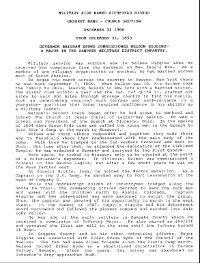Military Aide Named Richfield Bishop
Deseret News – Church Section
December 31 1966
From December 31, 1853
Governor Brigham Young commissioned Nelson Higgins-
A Major in the Sanpete Military District Infantry.
 Military service was nothing new to Nelson Higgins when he received his commission from the governor on New Year's Eve. As a member of one military organization or another, he had marched across most of North America.
Military service was nothing new to Nelson Higgins when he received his commission from the governor on New Year's Eve. As a member of one military organization or another, he had marched across most of North America.
He began his march across the country in Oswego, New York where he was born September 7, 1806. When Nelson was 10, his father took the family to Ohio, leaving Nelson in New York with his married sister. The sister died within a year and the lad, not quite 11, started out alone to walk 400 miles through strange country to find his family. Such a undertaking required much courage and self-reliance in a youngster- qualities that later inspired confidence in his ability as a military leader.
Nelson's second track began after he had grown to manhood and joined the Church of Jesus Christ of Latter-Day Saints. He was a Priest and President of the branch at Florence, Ohio. In the spring of 1834 when Orson Hyde came and called the young men in the branch to join Zion's camp in the march to Missouri.
Nelson and three others responded and together they made their way to Mansfield where they rendezvoused with the main body of the camp. With them he tramped to the far western frontier and back to Ohio. Not long after that, he attended the dedication of the Kirkland Temple, he was ordained a seventy and assigned to the First Quorum.
Once again, he treked to Missouri only to be ejected at the point of a militiaman's bayonnet. In Illinois, Nelson was commissioned a colonel in the Nauvoo Legion, but after a few short years he was on the move farther west.
At Council Bluffs, Iowa, he joined the Mormon Batallion. As a captain in the U.S. Army, he marched away to Fort Leavenworth at the head of company D.
While the nondescript column of infantrymen trudged along the Santa Fe Trail, the commanding officer decided to send the sick men and women with the children north to Pueblo, Colorado. Captain Higgins and ten able-bodied men were assigned to escort the group. Thus, the captain was cheated out of his opportunity to march to the west coast. In the summer of 1847, captain Higgins and his detachment moved northward and followed the pioneer company and marched into Salt Lake Valley.
He was one of the early settlers in Sanpete County where he received a commission of Infantry Major. He also served as sheriff and operated the first saw mill in the area until the Indians burned it down.
In Sanpete County and in his other colonizing efforts, Major Higgins was associated with Elder Orson Hyde of the council of the twelve. The two had been close friends since the Zion's camp march. Nelson joined Elder Hyde in a short-lived colonization in Carson Valley, Nevada. After two year's the colony was abandoned as Johnston's Army approached Utah.
Later, Major Higgins joined in the establishment of the town of Richfield, Utah. Elder Hyde visited the settlement in the spring of 1864 and appointed his old friend as the first bishop.
As both spiritual and military leader, Bishop Higgins guided his people through the dangers of the Black Hawk War with the Indians. He led them to a retreat to Sanpete Country when the danger became too great and returned with them when the war ended.
After his release as bishop, he served as Justice of the Peace in Richfield and Elsinor where he spend his last years. He died November 20, 1890 at the age of 84.
(Written for Deseret News by Arnold Irvine)